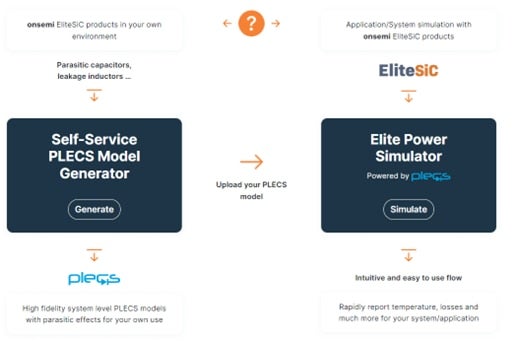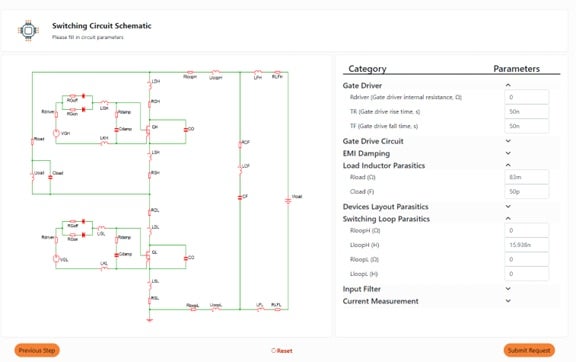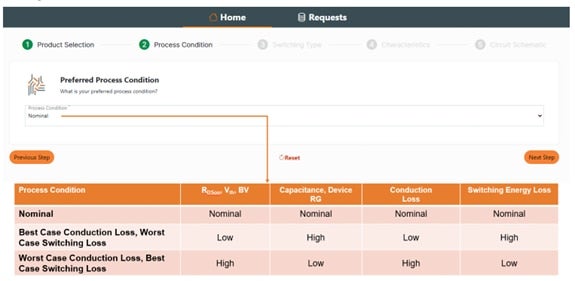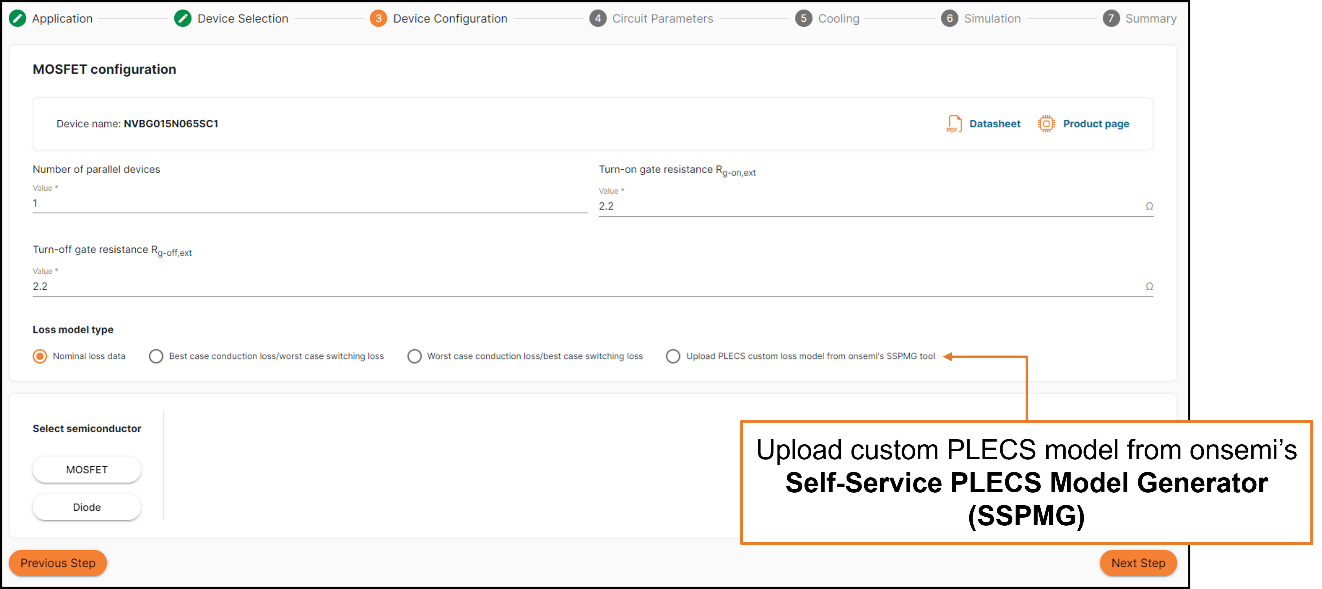onsemi recently released the Elite Power Simulator and Self-Service PLECS Model Generator (SSPMG). The Elite Power Simulator powered by PLECS is brought to our customers in a convenient online environment. The Elite Power Simulator brings several new features and advantages over the current industry state of the art. SSPMG is an industry break through tool that unlocks the flexibility and accuracy of the models used in PLECS simulations. Using the two tools in a systematic flow shown in Figure 1 enables our customers to design first time right power applications incorporating onsemi’s EliteSiC products.
Figure 1: How to Choose Elite Power Simulator and Self-Service PLECS Model Generator
PLECS models consist of look−up tables for losses (based upon manufacturer data sheets), along with a thermal chain in the form of a Cauer or Foster equivalent network. During simulation, PLECS interpolates and/or extrapolates based upon these loss tables to get the bias point conduction and switching losses for the circuit operation.
The conventional way to measure switching losses is the double pulse tester. onsemi’s advanced double pulse tester is valuable for measuring the lowest (or the device) losses with minimal effects from parasitic elements, allowing a comparison between various die sizes, RDS(ON) values, and packages. However, when a customer evaluates losses in their real application, the datasheet loss values will not reflect the observed losses. Upon further review, it becomes obvious that PLECS models based on datasheets are not representative of the end user’s application. Customers must make a compromise between cost and performances and so select less prefect inductors and capacitors than the one used in onsemi double pulse tester. Only if the user’s application has the same parasitic environment to that of the manufacturers datasheet double pulse test environment does it make sense to simulate with standard manufacturer provided PLECS models.
The better way to evaluate real customer losses is to introduce the customer real board and components (like inductors and capacitors) parasitic elements to the double pulse tester setup, making it specific to the customer application. Since this can be an insurmountable task in measurements, onsemi introduced the SSPMG to enable customers to design their PLECS models based on their application environment in a virtual prototyping environment. Although any virtual, simulation-based environment is only as good as the underlying models, onsemi’s highly accurate, physically based models are the SSPMG engine that customers can count on to achieve high fidelity PLECS models.
The SSPMG has more than 30 parameters to tune the double pulse tester simulation schematic to reflect customer real environment and extract losses for discrete SiC MOSFETs and SiC-based power modules as shown in Figure 3.
Figure 2: SSPMG Discrete Product Double Pulse Tester Schematic
These parameters are adjusted to reflect the particular cases and stages in the application. To enhance the simulation, gate drive voltages can also be customized. Customers can also set the boundaries and densities of their bias and temperature points in the loss tables. There is a limit to how many data points can be measured in the lab environment that is then typically provided in a datasheet. Through the virtual SSPMG environment, limitation on number of data points is removed, ensuring accurate interpolation and extrapolation by PLECS during simulation (Figure 2). However, as the classical double pulse tester is only valid in hard switching, it is not able to produce the losses incurred during soft switching operation. When using soft switching techniques (including fully resonant stages such as LLC, CLLC, etc. or transition resonant stages like Full Bridge Phase Shifted or Dual Active Bridge) soft switching is achieved if sufficient resonant energy is available before the switching event happens. If not, partial soft switching can be achieved if the energy is lower than required. If there is no resonant energy, then hard switching will occur. To include PLECS models that are valid for soft switching in the new onsemi Elite Power Simulator and SSPMG, a small modification is introduced in the classical double pulse tester and additional parameters (like dI/dt, dead time, Inductor value) are included to capture the resonant inductor energy when the switching event happens.
Figure 3: Self-Service PLECS Model Generator - Dense Loss Tables
Further customers are able to study the robustness of their applications to the inherent semiconductor process variation in manufacturing (e.g. datasheet limits). SSPMG enables customers to design their PLECS models for typical and correlated corner conditions for the conduction and switching losses as shown in Figure 4.
Figure 4: Self-Service PLECS Model Generator Features - Corner Model
Customers are given unprecedented flexibility to download their SSPMG designed PLECS models into their standalone PLECS design environment or to upload them directly into the Elite Power Simulator in the Device Configuration step shown below in Figure 5.
Figure 5: Upload Custom PLECS Model to the Elite Power Simulator
onsemi has developed an application note that looks at the technical advantages of onsemi's new Elite Power Simulator and SSPMG. There is a wealth of information dealing with circuit-level detail – especially how operating waveforms and losses can be affected by parasitic elements – and more.





